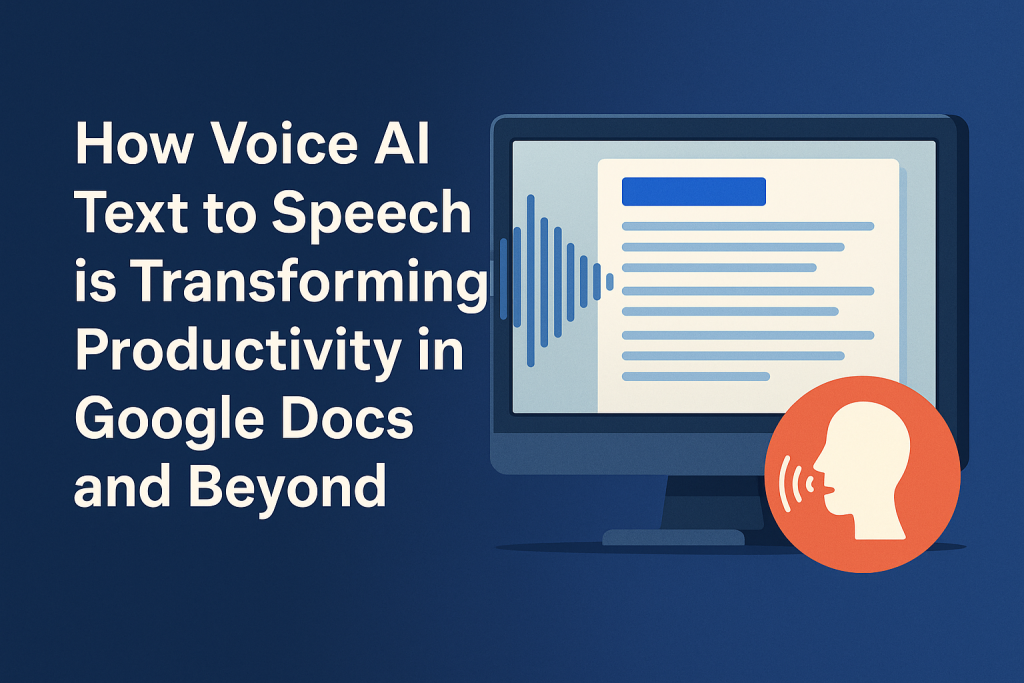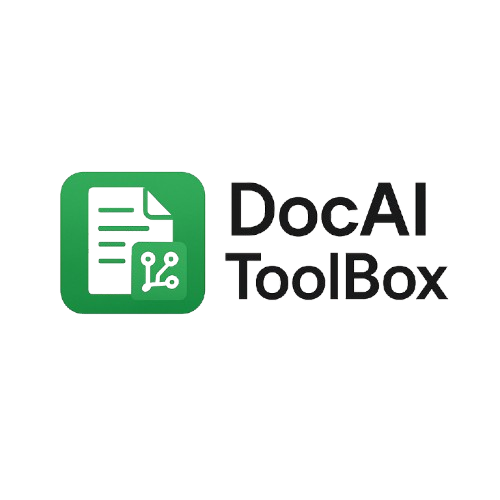How Voice AI Text to Speech is Transforming Productivity in Google Docs and Beyond

Artificial Intelligence (AI) has been steadily reshaping the way we work, study, and create. Among the most exciting advancements is Voice AI Text to Speech (TTS)—a technology that turns written text into natural-sounding audio.
Unlike the robotic, monotone voices from decades past, modern AI-powered TTS is powered by neural networks that mimic the rhythm, tone, and nuance of human speech. This leap in realism makes it useful not just for accessibility, but also for productivity, learning, and content creation.
Nowhere is this shift more impactful than in tools like Google Docs. Millions rely on Docs for writing and collaboration. When paired with voice AI text to speech, it allows users to listen to their documents, spot mistakes by ear, multitask while reviewing drafts, or make content more inclusive for diverse audiences.
Tools such as DocAIToolBox are at the forefront of this transformation, embedding AI-powered text-to-speech directly into Google Docs™ and Slides™, so users don’t need to juggle between apps.
Similar discussions can be found in publications like TechCrunch’s coverage of Google’s AI tools and Forbes’ articles on AI productivity, which highlight how embedding AI into everyday platforms is becoming the new normal.
1. Understanding Voice AI Text to Speech
What is Voice AI Text to Speech?
Voice AI text to speech is the process of converting written text into spoken words using advanced AI models. Unlike traditional rule-based systems, which sounded mechanical, modern TTS leverages deep learning to produce speech that’s remarkably human-like.
A useful primer is Google’s own Cloud Text-to-Speech documentation, which outlines how neural TTS differs from legacy systems.
Traditional TTS vs. AI-Driven TTS
- Traditional TTS: Relied on phonetic approximations. Results: flat, robotic voices.
- AI TTS: Uses neural networks (like Tacotron, WaveNet, VALL-E) trained on hours of recorded human speech to predict how text should sound, complete with intonation and pauses.
Microsoft Research explains this evolution well in their VALL-E paper, which demonstrates how AI can replicate voices with startling realism.
Benefits of Voice AI Text to Speech
- Accessibility: Empowers people with visual impairments or dyslexia.
- Productivity: Lets users “read” while multitasking.
- Comprehension: Hearing text out loud highlights awkward phrasing.
- Multilingual Support: Content can be voiced in dozens of languages.
A World Health Organization report emphasizes the importance of accessible tech, noting that over 2.2 billion people globally have vision impairments. TTS directly addresses this gap.
2. The Productivity Shift in Google Docs
Why Google Docs?
Google Docs is one of the most widely used cloud-based writing platforms, hosting everything from school essays to enterprise contracts. Yet productivity in Docs has traditionally relied on typing and silent reading.
Where Voice AI Text to Speech Fits In
When integrated into Docs, TTS changes the game:
- Editing drafts by ear: Writers can listen to their work and catch mistakes.
- Accessible editing: Users with disabilities can fully engage.
- On-the-go review: Listen to a report while commuting.
With DocAIToolBox, this workflow is seamless. Highlight text in a Google Doc, click “Convert Selected Text,” and instantly hear your words read aloud in a natural voice. No copy-pasting into separate software.
For example, EdTech Magazine has highlighted how AI in classrooms supports diverse learning styles, showing the role tools like Docs+TTS can play in education.
Real Scenarios
- Students: Convert notes into audio for review while walking.
- Professionals: Lawyers or managers listen to long documents on the way to meetings.
- Writers: Bloggers test how their content flows when spoken aloud.
3. Benefits for Different Audiences
Students & Educators
- Improve retention by combining reading + listening.
- Provide support for students with dyslexia or ADHD.
- Enable language learners to hear proper pronunciation.
The International Dyslexia Association has long recommended TTS as an assistive tool for learners.
Professionals
- Cut down on screen fatigue.
- Review content while multitasking.
- Catch tonal or grammatical issues by ear.
A Harvard Business Review article on productivity tools points out that auditory formats can improve comprehension and efficiency for busy professionals.
Content Creators
- Turn blogs into podcasts.
- Test scripts in real-time with AI narration.
- Create course audio lessons automatically.
Podcasters and creators on platforms like Buzzsprout have been discussing the overlap of written and spoken content, showing how TTS unlocks cross-format creativity.
Accessibility Users
- Empower visually impaired users to navigate documents.
- Meet compliance with accessibility standards (like WCAG).
According to the W3C Accessibility Initiative, text-to-speech is a cornerstone of inclusive design.
4. Beyond Google Docs: Expanding Use Cases
Voice AI text to speech doesn’t stop at Docs.
Google Slides
With DocAIToolBox, you can also generate voice narration for presentations in Slides™—perfect for teachers, trainers, and marketers who want to add a professional voiceover without recording themselves.
E-Learning Platforms
Convert written modules into audio lessons for auditory learners.
Corporate Communication
Turn training guides or HR policies into narrated explainers.
Marketing
Repurpose blogs into audio content or podcasts.
A case study from HubSpot showed that repurposed content in audio form extended reach by 20–30% compared to text alone.
5. Technical Deep Dive
How It Works
- Neural Networks like Tacotron 2 and WaveNet model human prosody.
- Inference predicts pronunciation, intonation, and pauses.
- Custom Models allow branded or personal voices.
For a clear overview, check out Google DeepMind’s WaveNet research.
Providers
- OpenAI TTS – natural, multi-style voices.
- Google Cloud TTS – strong multilingual support.
- Amazon Polly – widely used in e-learning.
- Azure Speech – enterprise-friendly with global coverage.
Security Concerns
Enterprise users must ensure sensitive Docs aren’t stored permanently by providers. Cloud Security Alliance has guidance on securing AI workflows.
6. The Future of Voice AI Text to Speech
Trends
- Voice Cloning: Personalized AI voices for individuals and brands.
- Emotion Control: Voices that adapt tone based on context.
- Conversational AI Agents: Docs that not only read but answer back.
Integration
Imagine asking Google Docs, “Summarize this in two minutes,” and receiving an instant narrated digest.
The concept of AI-powered work companions has been widely explored by MIT Technology Review, which predicts a surge in human-AI collaboration tools.
Accessibility Growth
As accessibility laws expand, expect TTS to be a baseline feature, not an optional one.
The rise of voice ai text to speech marks a turning point in how we consume and create information. In Google Docs, it transforms writing into a richer, more flexible experience: one where you can edit by listening, review while commuting, or make content accessible to all.
Beyond Docs, it empowers education, content creation, corporate training, and global communication. With companies like Google, OpenAI, and Microsoft pushing the boundaries, the next generation of TTS will be indistinguishable from human voices—and deeply embedded into the apps we use every day.
For readers interested in trying this technology directly in their workflow, DocAIToolBox offers a seamless way to experience voice AI text to speech inside Google Docs™ and Google Slides™. It’s one of the simplest ways to see how listening to your documents can save time, boost productivity, and make work more inclusive.
For further reading on the rise of AI-powered productivity, check out:
- The Verge: AI voice tools are changing how we create
- EdSurge: AI in classrooms
- Forbes: How voice AI is shaping business productivity
The future of productivity isn’t just written—it’s spoken.

